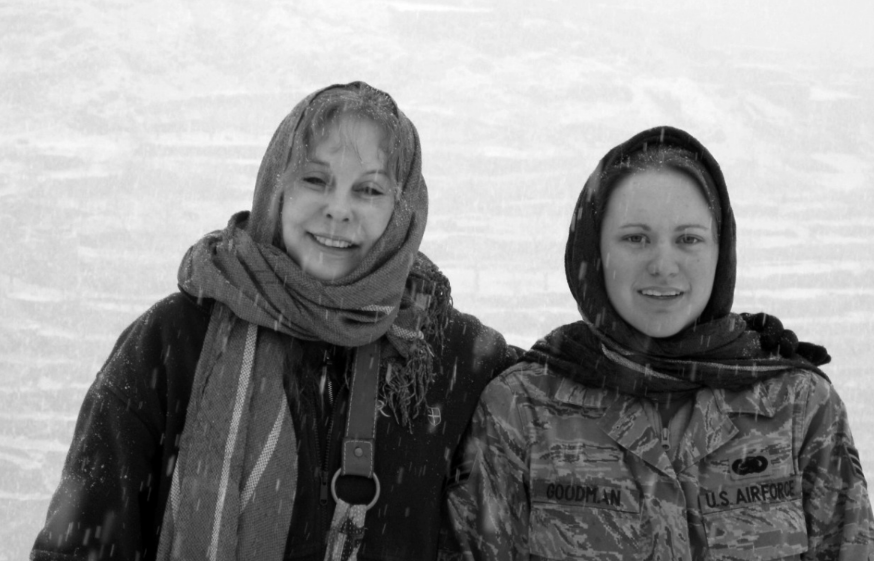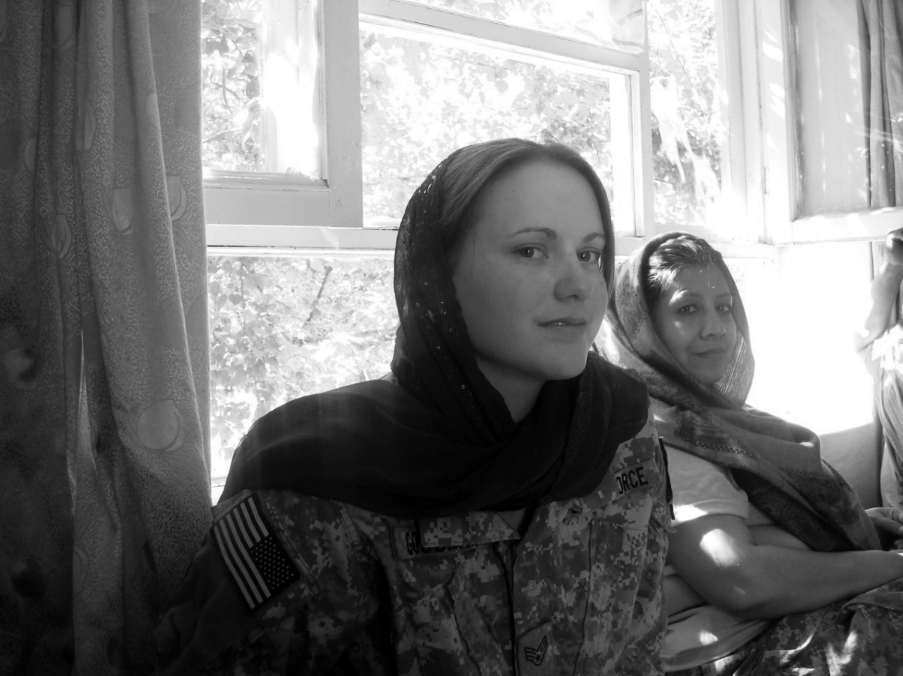Fiction
Thousand Languages
Reflejos en Latón
Fabián M Díaz Chacinuna introducción por Melissa Pitchard
En septiembre de 2008, leí un artículo en línea sobre soldados femeninas en Afganistán, miembros de los Equipos de Reconstrucción Provincial, o PRT, que vivían en provincias remotas, ayudando a construir carreteras, puentes, clínicas médicas y escuelas para los aldeanos afganos.
Es una historia en sí misma: cómo pasé de estar cautivada por la idea de conocer a soldados femeninas actuando en una capacidad pacífica como humanitarias, a varios meses de esfuerzo intensivo, obteniendo permiso de la Fuerza Aérea de los Estados Unidos para ser una periodista de guerra incrustada. Pero en enero de 2009, me encontraba primero en la Base Aérea de Bagram, entrevistando a pilotos de combate femeninas, y luego en un convoy militar viajando al norte hacia una pequeña base de operaciones avanzadas en las estribaciones de las montañas del hindú Kusch en la provincia de Panjshir.
En la Base de Operaciones Avanzadas (FOB) Lion, viví con las cinco mujeres militares allí, acompañándolas en misiones a escuelas y clínicas, visitando el santuario de Ahmad Shah Massoud, el héroe de Afganistán y un hijo de la provincia de Panjshir, y ayudando en la entrega de ayuda a familias empobrecidas organizada por estas soldados. Mi conductor en estas misiones era Ashton Lynn Marie Goodman, de veintiún años, o "Goodman", como prefería que la llamaran. Inicialmente intimidada por su lenguaje duro, sus palabrotas y su valentía militar, toda una fachada, como admitió más tarde, cultivado para sobrevivir en una cultura militar, llegué a conocerla como una mujer joven voluble, ingeniosa, altamente inteligente y valiente. A través de cursos en línea, estaba estudiando para obtener su licenciatura y planeaba convertirse en veterinaria. Anhelaba viajar por el mundo y era una aspirante a fotógrafa y escritora, extremadamente modesta acerca de lo que llamaba sus "pequeñas historias".
Cuando regresé a casa, mantuvimos correspondencia. Cuando le pedí que me enviara algo de su escritura, lo hizo, pero vacilante, con disculpas. Al leer las historias de Ashton, no me sorprendió ver lo mucho que reflejaban su personalidad: tierna, heroica, irreverente, preternaturalmente sabia, sinceramente honesta y graciosa. Poseía lo que Albert Camus describió una vez en su amiga Simone Weil, la filósofa y activista social: "una pasión por la verdad".
Después de que fue asignada al Comité de Asuntos de la Mujer, Ashton encontró un nuevo propósito en reunirse con mujeres del pueblo en shuras o consejos semanales, en defender los derechos de las mujeres y niños afganos. Me dijo que estaba aprendiendo a luchar con palabras, no con armas, y solicitó un segundo período de servicio en FOB Lion. Amaba a la gente de Panjshir y había encontrado significado en su trabajo con las mujeres. Cuando publicó su primer artículo, "Médicos del PRT de Panjshir Mejoran el Saneamiento Médico", en una publicación en línea de la Fuerza Aérea, lo envió a su familia, su novio y a mí.
El 26 de mayo de 2009, días antes de su vigésimo segundo cumpleaños, Ashton, o "Goodman", murió a causa de un artefacto explosivo improvisado (IED) mientras conducía a su comandante a la Base Aérea de Bagram.
Uno de los instintos del duelo es conmemorar, mantener viva a la persona que ha fallecido a través de homenajes. En noviembre de 2009, The Collagist publicó mi artículo que perfilaba a las cinco mujeres militares de la provincia de Panjshir. En mayo de 2010, O, The Oprah Winfrey Magazine, publicó mi historia destacada sobre Ashton. En junio de 2010, fundé el Fondo Ashton Goodman con el Proyecto de Escritura de Mujeres Afganas; las donaciones al Fondo de Ashton han ayudado a construir dos casas de escritura seguras para mujeres en Kabul y Herat, equipadas con acceso a Internet, computadoras portátiles y pequeñas bibliotecas. En diciembre, hablé sobre la vida de Ashton, su compromiso con las mujeres afganas, ante casi mil oficiales de la Fuerza Aérea en el Instituto de Tecnología de la Fuerza Aérea. Y en mayo de 2011, nueve candidatos a la Maestría en Escritura Creativa de la Universidad Estatal de Arizona participaron en la primera lectura teatral de poesía y prosa de escritoras afganas.
Pero había una promesa que me había hecho a mí misma y que aún no se había cumplido. Antes de su muerte, me había prometido que sería mentora de Ashton, ayudarla a publicar al menos una de sus obras de ficción. Ahora,
Hayden's Ferry Review, gracias a los actuales editores Laura Ashworth y Kent Corbin, me ha dado la oportunidad de cumplir esa promesa. "Reflexiones en Latón" es un artefacto que pertenece a un joven soldado que ahora está enterrada cerca de su hogar en Indiana, una joven cuyos sueños de ser veterinaria, escritora, fotógrafa, esposa y madre fueron truncados violentamente en una guerra sin ganadores. Este breve texto, escrito cuando Ashton era una soldado de diecinueve años en Irak, nos da apenas un vistazo de su promesa como escritora. La persona que era cuando lo escribió se transformó profundamente en los meses previos a su muerte: se convirtió en una portavoz de los derechos de las mujeres afganas, utilizando lo que llamó "el poder de las palabras, no de las armas", convirtiendo su espada en el arado de una clínica médica, una escuela, un artículo, una voz emergente de fuerza, ternura y feroz empatía.
En su libro, "Juana de Arco", la escritora Mary Gordon describe de esta manera a la santa guerrera francesa del siglo XV: "... Tiene la despreocupación, seguridad, disposición total para la entrega de una joven. Ama la vida; le tiene miedo a la muerte.
Esta chica presuntuosa, pura, exasperante, imprudente, olvidó quién era en una causa mayor que ella misma. Hablaba mucho y se contradecía a sí misma; murió en silencio. Pero incluso en la muerte, se niega a la soledad.
Pura, exasperante, presuntuosa, segura. Entregándose a una causa mayor que ella misma. Amando la vida, rechazando la soledad.
Oh, Ashton.
Reflejos en Latón por Ashton Lynn Marie Goodman
17 de enero / septiembre de 2008
Llovían balas de latón, balas de una ametralladora automática, cayendo a través de la torreta. Rebotaban inofensivamente en mi chaleco antibalas, la munición que ya había matado a otros y se había incrustado en la carcasa quemada de un tanque. Estaba oscuro afuera. El artillero actual se puso de pie en la torreta, agarrando la culata de la Ametralladora Ligera M249. Su rostro estaba presionado contra la mira térmica y luchaba por distinguir los blancos, verdes y negros que se suponía que eran nuestros objetivos. Los pies del artillero se movían incansablemente junto a los míos mientras intentaba encontrar la postura adecuada y disparar solo las balas más precisas.
Nuestra misión de entrenamiento en esta oscura noche era comprometernos y destruir "tanques enemigos" de acuerdo con las regulaciones que nos habían enseñado a seguir. Las palabras "Tanque enemigo a 600 metros, a las 12 en punto" fueron seguidas por "Identificado, en posición de fuego" y fluían libremente de la boca del artillero sin mucho pensamiento. ¿Cuándo se había vuelto tan común matar y destruir para nosotros y era esto normal? ¿Se suponía que debía sentir algo cuando llegara el momento de disparar esta arma a una persona real? Pero realmente no había mucho tiempo para pensar en esto. "¡Artillero, cáete!" gritó el encargado de nuestro Humvee. Nos indicó que era hora de cambiar de lugar. Era el turno de otra persona para manejar la ametralladora. Mi turno.
Incluso con mi pesado chaleco antibalas, mi pequeño tamaño me permitió entrar fácilmente en la torreta del tanque. El artillero anterior no lo tuvo tan fácil, los otros soldados en el vehículo habían tirado y forcejeado con su peso y tamaño para encajarlo en la torreta. Cayó de nuevo en mi asiento anterior y soltó un suspiro ruidoso, y me pregunté si los mismos pensamientos sobre matar le estaban pasando por la cabeza: ¿Es esto normal? ¿Sentiré algo cuando llegue el momento de disparar realmente a una persona?
Examiné mi entorno desde mi nuevo lugar en el tanque. La oscuridad reinaba por todas partes, solo interrumpida por una bala trazadora que cortaba la noche o por el ocasional destello de una granada cercana. "¡Más munición!" grité, con la voz ronca. Estaba practicando mis habilidades de combate. Al principio de mi carrera militar, me había acostumbrado al hecho de que pasaría una cantidad ridícula de tiempo practicando el arte de matar en diferentes campos de tiro. Había docenas de armas para calificar. Este campo de tiro en particular estaba diseñado para darles a los artilleros tiempo en la torreta de un Humvee, tiempo para familiarizarse con la sensación de tener armas en sus manos. Es un sentimiento poderoso tener un arma a tu disposición. Es liberador y sofocante. Cargué mi arma con una cinta de munición y cerré la bandeja de alimentación. La culata era suave bajo mi mano enguantada. Busqué el mejor agarre y posición de la mano alrededor del arma.
El campo de tiro sorprendentemente estaba tranquilo. Los artilleros dejaron de disparar. Coloqué mi mano en el gatillo e identifiqué mi objetivo. Imaginé que los tanques a lo lejos eran el enemigo; personas que querían matarme. Nunca sentí la rabia que algunos soldados sentían cuando pensaban en el enemigo. Realmente, no sentía mucho acerca del enemigo. ¿Era esto señal de frialdad o un mecanismo de defensa? No estaba seguro de que importara de ninguna manera. El encargado saltó sobre el capó e inspeccionó el arma para asegurarse de que la había cargado correctamente. Esperé las palabras mágicas, con el dedo en el gatillo. "Tanque enemigo a la vista, 400 metros, a las 12 en punto. Identificado. En posición de fuego". Tirando hacia atrás en un solo movimiento suave contra la soldadura del gatillo, las balas estallaron desde el cañón hacia la noche.
El único indicador de que realmente había alcanzado mi objetivo fue la cascada de chispas brillantes que iluminaron los terraplenes en el carril. Las ráfagas de cinco a siete rondas eran el estándar para la M249 SAW y para contar este número en mi cabeza, recitaba las palabras, "Muere, cabrón, muere. Muere, cabrón, muere". Finalmente, me quedé sin munición. El cañón del arma brillaba con un tenue color naranja y las gotas de lluvia hacían pequeños ruidos de chisporroteo al caer sobre el metal caliente. El personal de instrucción me ordenó que despejara el arma de balas, pero ya lo había hecho. Salí de la torreta y el siguiente soldado se acercó para repetir el mismo ejercicio. Me senté en el asiento que acababa de desocupar, llevando mi chaleco antibalas, y escuché la música del campo de batalla. El destello de una granada iluminó el oscuro cielo como un relámpago. Fue suficiente para ver la silueta de un tanque abandonado en la distancia. Las gotas de lluvia golpeaban mi chaleco y hacían pequeños ruidos metálicos. Pensé en la primera vez que disparé un arma en el entrenamiento básico. Mi M16 era viejo y desgastado, pero cumplía su cometido. Al principio, me asustaba el peso del rifle y lo que el arma podía hacer. Pero no pasó mucho tiempo hasta que me di cuenta de que un arma es servidora de su manejador. Un arma solo hará lo que se le diga que haga.
Share This Spanish Translation

